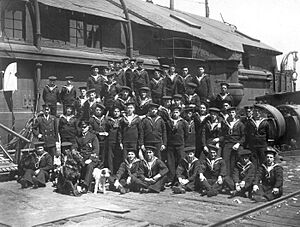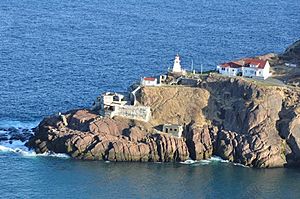Fort Waldegrave, Newfoundland and Labrador facts for kids
Fort Waldegrave was a special place with big guns, also called a battery. It was in St. John's, Newfoundland. This fort was built in a smart spot, looking over the Narrows and St. John's Harbour. The Narrows is the narrow entrance to the harbour.
Contents
Why Fort Waldegrave Was Built
Fort Waldegrave was first built in 1798. It stood where an older fort, Old North Castle, used to be. The fort was named after Governor Waldegrave. It is located on the side of Signal Hill. This spot is on the northern side of The Narrows, which is the way into St. John's harbour. The fort helped protect the harbour along with another defense point called Chain Rock.
Protecting the Harbour Entrance
Fort Waldegrave also worked with Fort Amherst. Fort Amherst was on the other side of the Narrows. Two rocks, Chain Rock and Pancake Rock, are on opposite sides of the Narrows. They are about 174 meters (570 feet) apart. To stop enemy ships, a huge defensive chain was stretched between these rocks at night. A capstan (a type of winch) was used to pull the chain tight. People used Chain Rock and Pancake Rock for this defense as early as 1770.
Fort Waldegrave itself had a guardhouse, two cannon, and a mobile storage area for gunpowder.
The Seven Years' War and St. John's
The forts on the other side of the Narrows were named after Lieutenant Colonel William Amherst. He successfully took St. John's back from French forces in 1762. This happened during the Seven Years' War, which was fought from 1756 to 1763. In this war, France and Britain were fighting to be the most powerful in North America.
In 1762, near the end of the war, French forces attacked St. John's. If they had won, it would have helped France in peace talks. The French took St. John's and raided nearby towns. But British troops, led by Amherst, eventually defeated them at the Battle of Signal Hill. This was the last battle of the war in North America. It made the French surrender to the British. After this, the British government controlled all of eastern North America.
Fort Waldegrave was rebuilt in 1810. It was kept in good condition until the late 1860s.
Fort Waldegrave in World War I
During World War I, Fort Waldegrave became very important. On July 8, 1916, it was the only active defense site for St. John's. A powerful BL 6-inch gun Mk II was placed there. It sat on a gun carriage inside a round stone wall for protection. This gun came from HMS Calypso. This was a British Royal Navy training ship. During World War I, it was stationed in St. John's. In February 1916, the ship was renamed HMS Briton.
Royal Navy Reservists from the ship helped guard the fort. They each had a .303 rifle. They worked with the Legion of Frontiersmen, led by Lieutenant Edward W. Vere Holloway and Sergeant Joseph Russell.
A small building for soldiers (barracks) and a dining hall (mess hall) were also nearby. They had office space too. These buildings were surrounded by a stone wall with gates. Even with all these defenses, Fort Waldegrave did not see any fighting during World War I.
In 1920, the barracks building was sold and became a dance hall. The wall and other buildings were taken apart. Their stones were used to fix the Anglican Cathedral of St. John the Baptist and to build house foundations in the 1940s. The round stone wall around where the gun was placed still remains from World War I.
During World War I, the old defensive chain was replaced with anti-submarine nets. These nets helped stop enemy submarines.
Fort Waldegrave in World War II
During World War II, Chain Rock was used again. A large chain and anti-submarine boom were connected from Chain Rock to Fort Amherst. This was done to stop German U-boats (submarines) from entering the harbour.
The Battery Neighbourhood
The Battery is also the name of a small neighbourhood in St. John's. Fort Waldegrave was located in this area. In the 1920s, a large stone building was built near the bottom of the headland. It was first used as a hotel, called the Hotel Newfoundland. In the Lower Battery area, where US Army Dock Road is now, there used to be railway tracks.
The Grand Concourse Walkways
The Grand Concourse is a big network of walkways. It covers St. John's and nearby towns like Mount Pearl and Paradise. It is 125 kilometers (about 78 miles) long. These walkways connect rivers, lakes, parks, and historical sites like Fort Waldegrave. You can find this fort by following the "Concourse Harbourside Walk East" path. The people who manage the Grand Concourse also put up information boards at interesting spots along the walkways.



